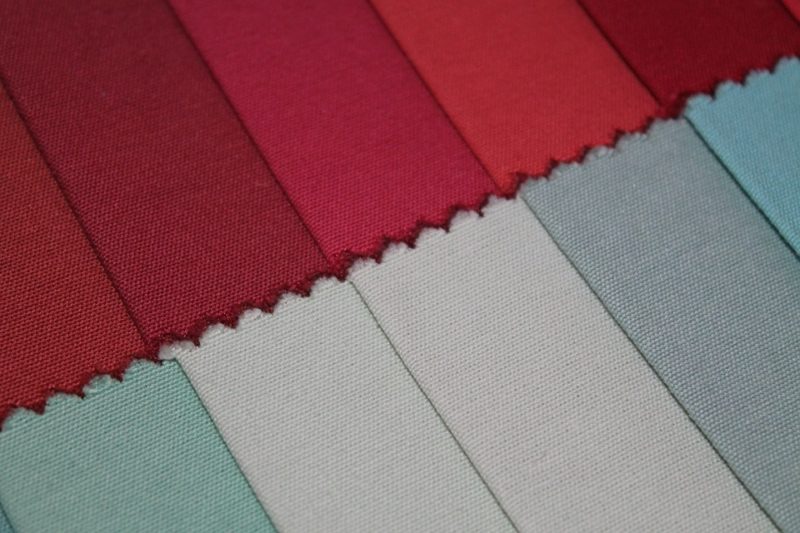The answer to what does cut on the bias mean in sewing is following the bias when cutting. We will explain this in more detail below, including how you cut on the bias for your projects.
Feel free also to browse our blog for related sewing terms. For example, do you know what is grainline in sewing?

It’s crucial to familiarize yourself with these sewing terms to follow different patterns accordingly.
What Is A Bias In Sewing?
The bias in sewing refers to any diagonal grainline. However, the true bias is the diagonal line running 45 degrees intersecting the length of the grain and cross-grain of the fabric.
Therefore, every fabric piece will always have two true biases perpendicular to each other. The length of the grain is also called the warp, and the cross grain of the woven fabric is the weft, so be mindful when these terms are used.
What does cut on the bias mean in sewing?
The bias cut means you will cut the fabric from a diagonal angle to the straight grain or weave of the material. Please note that while any diagonal cut on the lengthwise or crosswise grain can be considered a bias cut, always refer to the true bias when the pattern calls for it.
Cutting the fabric at a 45-degree angle will ensure that it will give the material more elasticity, especially when making garments that must follow the contours of the body. You’ll be eliminating the tension from the weave since you’ll cut along the bias grain, hence the elasticity.
How Do You Cut On The Bias?
- Place the fabric over the cutting table and mat, ensuring that it’s completely flat
- Check if the fabric’s lengthwise grain is parallel to the selvages and its cross grain is perpendicular to the selvages
- The lengthwise grain of the fabric should also be across its full length
- Place some weights on the material and then tape its selvage and horizontal cut with painter’s tape for stability
- Mark a diagonal line 45 degrees to the selvage using the markings on the cutting mat with a fabric marker
- Put the sewing pattern over the fabric and secure it in place with pattern weights
- Make sure the diagonal line you made is aligned with the centerline on the pattern; pin if needed
- Cut the fabric with a rotary cutter without lifting the material too much
- Cut the notches accordingly into the seam allowance
Do you know that you can also use bias cuts for making pipings? Read more about what is piping in sewing.
How to cut bias strips for binding and piping
- Prepare a square cut of fabric
- Find the 45-degree angle and cut enough fabric strips according to the length you need
- Do not stretch on the material when cutting
- Pin the strips perpendicular to each other
- Align the raw edges together and join the strips with diagonal seams
- Trim the excess material with ¼ inch of seam allowance
- Press the seams open
It’s also possible to make a continuous bias binding from one square fabric piece, but it will be trickier.
How Do You Know If Fabric Is Cut On The Bias?
You can quickly identify that the fabric is cut on the bias when the space between the warp and weft is no longer visible. The material is also noticeably softer, thinner, and does not fray.
Additionally, the stretch allows the fabric to drape itself. Therefore, it’s important that you also cut the two true biases perpendicular to each other.
Where is the bias grain of fabric?
Fold the fabric selvage at a right angle to put the selvage parallel to the crosswise grain. The bias grain will form a 45-degree angle to the selvage.
Why Do You Cut Fabric On The Bias?
Starting in the 1920s, cutting the fabric on the bias can be helpful in garments where you want drapes and curves. The stretch is also beneficial for accentuating the body for a slimmer silhouette. And when a fabric is cut on the bias, the edges are less prone to fraying, so the bias tape is also famous for finishing projects.
Overall, cutting on the bias is excellent when working on dresses, gowns, and skirts because of the form-fitting finish and soft drape. But if you’re new to sewing on the bias, select a pattern with minimal seams on lightweight fabric for a much easier sewing experience.
What fabric is best for cutting on the bias?
Satin, velvet, and silk are among the best materials when cutting on the bias. However, for people cutting on the bias to get a good drape, you can also consider natural fabrics with an open weave, crepe, or even sheer fabrics like chiffon.
Do all fabrics have a bias?
Some fabrics like muslin and microfiber are not suitable for bias cuts. Polyester, canvas, and other materials with a tight weave will also be challenging to cut on the bias.
Conclusion
And that’s it! We just found out what does cut on the bias mean in sewing that is cutting on a diagonal angle to the straight grain of the fabric.
Cutting on the bias is advantageous when making garments that need stretch, soft drape, or simply avoiding fraying. Fabrics cut on the bias look thinner and softer as well.
We hope this was a helpful read; leave us a question if you have any.
